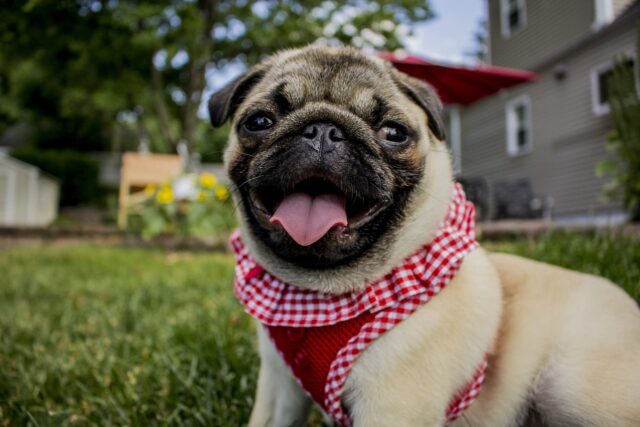
evrymmnt / Shutterstock.com
If you love the look and feel of long-haired cats, you have many breeds to choose from. Although the ultra-long, fluffy coats seen in Persians, Siberians, and similar long-haired breeds require daily grooming and brushing, the silky, semi-long coats seen in breeds like Balinese and Oriental Longhairs are less likely to tangle and need minimum upkeep.
Let’s meet 14 long-haired cat breeds with beautiful, long coats.
#1 Balinese
Eric Isselee / Shutterstock.com
The Balinese is essentially a long-haired Siamese. The breed was developed in the United States in the 1950s, using long-haired Siamese kittens that popped up litters of short-haired Siamese. One of the breed founders named these elegant, long-haired cats after the graceful Balinese dancers from Indonesia. Balinese are loving, affectionate, and friendly cats that bond closely with their human family.
The Balinese’s semi-long coat lies close to the skin and has a very slight undercoat. Fine and silky in texture, the coat is shortest on the shoulders and longest on the tail, which is a feathery plume. Balinese cats come in all pointed colors, including traditional colors (seal, chocolate, blue, and lilac) and non-traditional colors and patterns (red, cream, lynx point, and torte point).
#2 Birman
Borkin Vadim / Shutterstock.com
Birman cats trace their roots back to Burma (today, Myanmar), where they were thought to be companions to priests in temples. They are often called the Sacred Cat of Burma. Birmans were standardized in France in the 1920s and later made their way to the United States, where they quickly became a favored breed. Birmans are quiet, gentle, friendly, and laid-back pets.
The Birman’s silky coat is semi-long to long with no undercoat. The tail is very full and fluffy, and male Birmans especially have a heavy ruff around the neck. Birmans come in pointed colors and always have four white paws. They have medium to large, rounded eyes that are always blue.
#3 British Longhair
Nynke van Holten / Shutterstock.com
Most cat aficionados are familiar with the British Shorthair, but you might not know about the breed’s long-haired cousin, the British Longhair. Back in the early 1900s, British Shorthairs were crossed with Persians, introducing the gene for long hair. British Longhairs look and act much like British Shorthairs, but have long hair. They are slightly reserved, especially with strangers, but affectionate and devoted to their human family.
The British Longhair’s semi-long coat is rich, plush, and thick, with a ruff around the neck and britches (longer hair on the backs of the thighs). According to the breed standard, the hair is so dense that it’s difficult to see the skin when parting the hair. British Longhairs can be any color or pattern.
#4 Himalayan
Cindy Ching / Shutterstock.com
The Himalayan cat is a Persian that comes in the pointed color pattern seen in Siamese cats. The Cat Fanciers Association (CFA) recognizes the Himalayan as a color division of the Persian breed. The International Cat Association (TICA) lists the Himalayan as a separate breed from the Persian. Like Persians, Himalayan are sweet, affectionate, gentle, and quiet.
The Himalayan’s coat is long all over the body with a very dense undercoat that gives it lots of volume. Himalayans have an immense ruff around the neck. The coat may be any pointed color (including red, cream, seal, blue, chocolate, lilac, tortoiseshell, and blue-cream) and may be solid or come in a pointed pattern (such as tortoiseshell, bicolor point, tricolor point, tabby or lynx point, smoke and shaded point).
#5 Maine Coon
Seregraff / Shutterstock.com
The Maine Coon developed naturally in Maine, where it developed a rugged coat and body type appropriate for the cold North Eastern climate. They have long been prized for their vermin-hunting skills. Maine Coons are one of the largest cat breeds, with males often tipping the scales at 20 pounds or more. Maine Coons are laid-back, friendly, and loyal companions.
Maine Coons have shaggy-looking coats with a slight undercoat. The hair on the tail and belly is long, and Maine Coons have a ruff around the neck and britches on the backs of the thighs. The all-weather coat has a silky texture. Maine Coons come in a variety of colors and patterns, but they cannot be chocolate, lilac, cinnamon, fawn, or caramel.
#6 Norwegian Forest Cat
Linn Currie / Shutterstock.com
The Norwegian Forest Cat evolved naturally in Scandinavia many centuries ago. This breed, which is called the “Skogkatt” in its native land, even voyaged with the Vikings, providing valuable vermin control. The Norwegian Forest Cat is calm, loyal, and playful well into adulthood.
The Norwegian Forest Cat’s semi-long, water-resistant coat protects these cats from harsh environments. It’s of a dense, wooly undercoat and a long, coarse, glossy overcoat, with a neck ruff and britches. Norwegian Forest Cats come in any color or pattern, with or without white markings.
#7 Oriental Longhair
Nynke van Holten / Shutterstock.com
The Oriental Longhair is a close cousin to the Oriental Shorthair. Both breeds were created in England shortly after World War II when cat breeders had limited pedigreed cat populations and began experimenting by crossing the breeds they had available. Identical but for the length of the coat, Oriental Shorthairs and Longhairs are affectionate, energetic, and extremely people-oriented.
The Oriental Longhair’s coat is semi-long and close-lying to the skin, with a slight undercoat. It has a fine, silky texture. The coat is longest on the tail, where it forms a plume. Oriental Longhairs come in non-pointed colors and patterns, such as solid (black, white, blue, chocolate, lilac, cinnamon, caramel, fawn, red, cream, and apricot), tortoiseshell, smoke, shaded, or tabby.
#8 Persian
Linn Currie / Shutterstock.com
Ancestors of the Persian cat traced ancient roots to Persia (Iran), though the breed was refined in Italy in modern times. The hallmarks of the Persian breed are the very long, thick coat and a round, flat face. Persians are exceptionally sweet, gentle, quiet, and loving cats.
The Persian’s coat is very long all over the body. A dense undercoat pushes the coat out from the skin, making it look very fluffy and full. Persians have an immense ruff of fur around the next and a very long, fluffy tail. They come in many different colors and patterns, including white, black, red, cream, blue, chocolate, lilac, silver, golden, blue-cream, sable, tortoiseshell, bicolor, tricolor (calico), tabby, smoke, shaded, and Himalayan (pointed).
#9 Ragdoll
Esin Deniz / Shutterstock.com
Named for its tendency to relax into your arms and lie there like a ragdoll, the Ragdoll cat was created in California in the 1960s using a white longhaired cat named Josephine, a seal point mitted male cat, and a few others. Ragdolls thrive on lots of attention from their people. They are outstanding snugglers and lap warmers.
The Ragdoll’s semi-long coat is very silky and soft, with minimal undercoat. The coat naturally resists matting, making it easy to care for. All Ragdolls are pointed, with lighter-colored bodies and darker points of color on the head, legs, and tail. Some Radgolls have white markings. Ragdolls always have blue eyes, with deeper color preferred.
#10 Selkirk Rex Longhair
dien / Shutterstock.com
The Selkirk Rex has a curly coat unlike any other in the cat world. A new breed, the Selkirk Rex was developed in the 1980s when a unique kitten born to a feral mother cat caught the eye of a Persian breeder. This kitten, named Miss DePesto, which had curly whiskers and a wavy coat, went on to become the foundation of the breed. The Selkirk Rex is mellow yet also playful.
The Selkirk Rex comes in two coat types: shorthaired and longhaired. The Selkirk Rex Longhair has a dense, soft, plush, semi-long coat that forms loose, individual curls. Selkirk Rex come in all colors and patterns.
#11 Siberian
Kanyshev Andrey / Shutterstock.com
The Siberian cat is a natural breed that evolved in Russia without human intervention as long ago as 1000 AD. The breed was exhibited at the first cat shows in the late 1800s, but Siberian cats were not officially recognized in the United States until the 1990s. Siberians are affectionate, playful, and cuddly.
The coat of the Siberian cat has a feature not seen in any other breeds. Rather than a double coat, the Siberian has a triple coat with three distinct layers of hair that keep the cats warm in winter. Siberians shed a lot of their undercoat in summer. The texture can vary from coarse to soft, and the coat can be any color or pattern, with or without white.
#12 Somali
Nataliya Kuznetsova / Shutterstock.com
The Somali cat is essentially a longhaired Abyssinian. The breed came about when breeders embraced a recessive gene mutation for long hair that popped up in Abyssinian litters. Somalis look and act the same as Abyssinians, but have long semi-long hair. Somalis are active and playful, and bond tightly with their human families.
The Somali has a soft, dense, fine-textured double coat coat that forms a slight ruff around the neck and britches on the backs of the thighs. Like Abyssinians, Somalis have ticked coats in the agoutti pattern–each individual hair is banded alternating rings of light and dark color. Somalis come in ruddy, cinnamon, blue, and fawn (and in some registries, chocolate and lilac).
#13 Turkish Angora
Daniyal112 / Shutterstock.com
The Turkish Angora developed hundreds of years ago in Turkey, where the breed is considered a national treasure. By the early 1900s, the breed nearly went extinct, but it was saved thanks to breeding programs in Turkey, and later, the United States. Turkish Angoras are affectionate, loyal, and playful with an endearing impish streak that has some describing them as the feline equivalent of clowns.
The Turkish Angora’s silky, fine, semi-long coat looks to be single coated, but it has a slight undercoat. The hair on the stomach can be somewhat wavy. The coat is medium-long on the body, and the tail has a full plume. Turkish Angoras come in many colors and patterns, although solid white is perhaps the most recognizable.
#14 Turkish Van
Lea Rae / Shutterstock.com
The Turkish Van is believed to have evolved in the mountains of eastern Turkey. Tourists traveling in Turkey in the 1950s were captivated by the beautiful white cats with colored markings on their heads and tails. The couple brought a male and a female kitten back to England where the began a breeding program. The Turkish Van is affectionate and social, with a knack for getting into things.
The Turkish Van’s semi-long coat is single with no undercoat. It’s very soft with a texture like cashmere. Turkish Vans drop some of their coat in warmer months, so the winter coat is thicker and longer than the summer coat. The Turkish Van can be solid white or white with the van pattern (color on the head and tail only).






